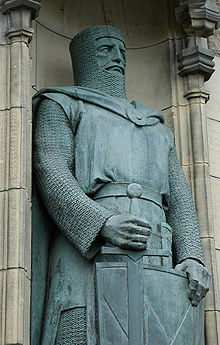Sir William Wallace (Norman French:William le Waleys) died 23 August 1305) was a Scottish landowner and descendant of the ancient kings of Northwest Britain. He became one of the main leaders during the Wars of Scottish Independence.
Along with Andrew Moray, Wallace defeated an English army at the Battle of Stirling Bridge in 1297, and was Guardian of Scotland, serving until his defeat at the Battle of Falkirk in July 1298. In 1305, Wallace was captured in Robroyston near Glasgow and handed over to King Edward I of England, who had him hanged, drawn and quartered for high treason and crimes against English civilians.
Edward I had used Sir William Soulis to obtain Cruggleton from the Mac Cairills in 1282. William Wallace had assisted William Mac Cairill in recapturing Cruggleton, and he and Wallace wanted independence for Scotland from England. Mac Cairill accompanied Wallace to meet Robert the Bruce July 1st (August?), 1305 near Glasgow. With them was John Stewart of Ruskie who was to betray them. Mac Cairill (M’Kerlie) was asleep and was slain. Wallace awoke at the noise and resisted, but was captured.
Since his death, Wallace has obtained an iconic status far beyond his homeland. He is the protagonist of the 15th-century epic poem The Wallace, by Blind Harry. Wallace is also the subject of literary works by Sir Walter Scott and Jane Porter and of the 1995 Academy Award- winning epic film Braveheart.
William Wallace was a member of the lesser nobility of Scotland but little is definitely known of his family history. Records show early members of the family as holding estates at Riccarton,Tarbolton, and Auchincruive in Kyle, and Stenton in Haddingtonshire. They were vassals of James Stewart, 5th High Steward of Scotland (himself decended from the ancient British kings of Brittany and an ancestor of William of Orange) as their lands fell within his territory. The traditional view regards William’s birthplace as Elderslie in Renfrewshire, and this is still the view of most historians, but there have been recent claims that he came from Ellerslie in Ayrshire. There is no contemporary evidence linking him with either location, although both areas had connections with the wider Wallace family.
The Wallace family first came to Scotland with a Norman family in the 11th century. King David was eager to extend the benefits of Norman influence and gave grants to the nobles of the south. Among them was Walter FitzAlan, who the Scottish king appointed his Steward in 1136. One of FitzAlan’s followers was Richard Wallace from Oswestry who came north to try and improve his fortunes. Oswestry is on the Welsh border and the name Wallace means “Welshman” in its broad sense, as of Old British descent from lands stretching from Strathclyde, Aeron (Ayrshire), Galloway, Cumbria, Lancashire, Wales, Cornwall and Brittany.
Lord FitzAlan received from King David lands in Ayrshire and so it was here that his follower Richard Wallace settled. Richard Wallace was granted his own estate in Kyle, where it is claimed that his name Richard is still remembered in the placename of the village of Riccarton. While tradition claims Sir Malcolm Wallace of Elderslie as the father of three sons, Malcolm, John, and William Wallace, the seal of William Wallace, rediscovered in 1999, identifies William as the son of Alan Wallace of Ayrshire, who appears in the Ragman Roll of 1296 as “crown tenant of Ayrshire”. Dr. Fiona Watson in “A Report into Sir William Wallace’s connections with Ayrshire”, published in March 1999, reassesses the early life of William Wallace and concludes, “Sir William Wallace was a younger son of Alan Wallace, a crown tenant in Ayrshire”.
